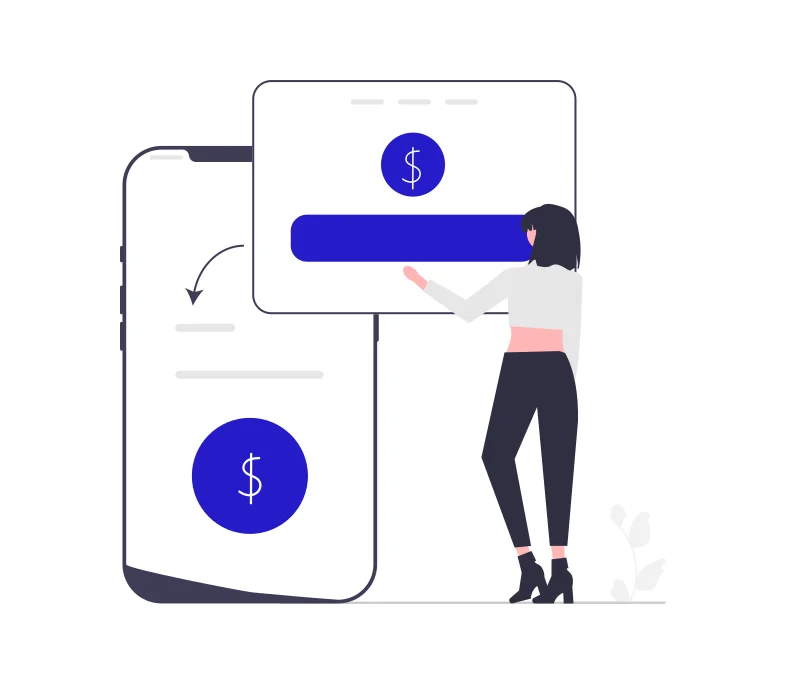Get a Cashback Credit Card today
Best Cashback Credit Cards in Norway
Compare types of cash back credit cards
See what perks that fit you
Apply today and get an instant answer
Cashback credit cards in Norway offer a simple and effective way to earn rewards on your everyday spending. Whether you’re shopping for groceries, filling up the tank, or dining out, these cards return a percentage of your expenditures back to you.
We will explore the top cashback cards available, focusing on their benefits and how they can align with your spending patterns. Choosing the right cashback card allows you to optimize your earnings on everything from groceries to fuel to dining out. Discover how these cards can boost your financial efficiency, offering real rewards that accumulate with your everyday spending.
What is a Cashback Credit Card?

A cashback credit card is a credit card that offers cardholders a return on their spending. When you make purchases using a cashback card, a percentage of the amount spent is credited back to your account. This feature differentiates cashback cards from other types of rewards cards, which might offer points or miles instead.
The cashback you earn is essentially a rebate on your purchases. The rate at which you earn this cashback can vary by card and by the type of purchase. For example, some cards offer a flat rate on all purchases, while others provide higher cashback rates on specific categories like groceries, fuel, or dining.
Here are the benefits of cashback credit cards:
- Earning Rates: These can vary widely. Some cards offer a single rate on all purchases, while others have tiered rates depending on the spending category or the amount you spend.
- Redemption Options: Cashback can typically be redeemed as a statement credit, directly reducing your credit card balance. Some cards also allow redemption for gift cards, merchandise, or even as a deposit into a bank account.
- Sign-up Bonuses: Many cashback cards offer initial bonuses for new cardholders, such as earning extra cashback in the first few months or after spending a certain amount.
- Annual Fees: Some cashback cards come with annual fees, while others do not. The best card for you will depend on whether the benefits and cashback you earn outweigh any fees.
- Interest Rates: Like other credit cards, cashback cards come with interest rates that apply if balances are carried over from month to month. It’s important to balance the benefits of cashback earned with any potential interest charges if you don’t pay the balance in full.
Types of cash back credit cards
Cashback credit cards come in various formats, each designed to cater to different spending habits and preferences. Understanding these types can help you select the best card for your lifestyle. Here’s a breakdown of the primary types of cashback credit cards available in Norway.
Flat Rate Cashback Cards
Flat rate cards are the simplest type of cashback credit cards. They offer a consistent cashback rate on all purchases, regardless of the category. For example, a card might offer 1.5% back on every purchase you make. This straightforward approach is ideal for those who prefer simplicity and predictability in their rewards, without the need to track spending categories or sign up for special offers.
- Pros: Easy to understand and use; no need to track spending categories.
- Cons: Might not offer the highest possible cashback on specific categories like groceries or dining.
Tiered Cashback Cards
Tiered cashback cards offer different cashback rates based on the purchase category. For instance, a card might offer 3% back on groceries, 2% on fuel, and 1% on all other purchases. This type is beneficial for those who spend consistently in specific categories, allowing them to maximize their rewards based on their spending habits.
- Pros: Higher cashback rates on popular spending categories.
- Cons: Requires more attention to maximize benefits based on spending patterns.
Rotating Categories Cashback Cards
These cards offer higher cashback rates in specific categories that change periodically, typically every quarter. For example, you might earn 5% on grocery stores in one quarter and 5% on gas stations the next. Cardholders usually need to activate or opt-in to these rotating categories to earn the bonus rates.
- Pros: Potential to earn high cashback rates in varying categories throughout the year.
- Cons: Requires active management to enroll in and track the changing categories to maximize cashback.
How to apply for a cash back credit card
Applying for a cashback credit card in Norway is a straightforward process that can help you start earning rewards on your purchases. Here’s a step-by-step guide to ensure a smooth application:
- Research and Compare: Start by researching different cashback credit cards available in Norway. Compare their cashback rates, bonus offers, annual fees, and other relevant features to find the one that best suits your spending habits.
- Check Eligibility Criteria: Before applying, ensure you meet the eligibility requirements for the card. This typically includes age, income, and credit history criteria.
- Gather Necessary Documentation: Prepare the documents required for the application, which may include identification, proof of income, and proof of residency.
- Fill Out the Application Form: Go to the issuer’s website and complete the online application form. You’ll need to provide personal and financial information, such as your name, address, income details, and employment information.
- Review Your Information: Double-check the information you’ve entered in the application to ensure it’s accurate and complete. Any errors or omissions could delay the processing of your application.
- Submit the Application: Once you’ve reviewed your information, submit the application. The credit card issuer will then assess your creditworthiness, which typically involves a credit check.
- Wait for Approval: After submitting your application, there will be a waiting period while the issuer reviews your application. If additional information is needed, they may contact you.
- Receive and Activate Your Card: If your application is approved, you’ll receive your cashback credit card by mail. Follow the instructions provided to activate it, and start using it to earn cashback on your purchases.
Best Cashback Credit Cards in Norway 2026
Cashback cards aren’t one-size-fits-all. Some reward everyday shopping, others focus on online purchases, and a few offer consistent value across all categories. Below is a comparison of the best cashback credit cards in Norway right now.
| Card Name | Cashback Rate | Bonus Offer | Annual Fee | Best For |
|---|---|---|---|---|
| re:member Black | Up to 20% via affiliate stores | None | 0 NOK | Online shopping & campaigns |
| Morrow Bank | 1–4% on all purchases | None | 0 NOK | Everyday spending |
| Bank Norwegian Visa | 0.5–1% via CashPoints (travel-related) | Earn CashPoints | 0 NOK | Travel + general purchases |
- re:member Black gives you access to over 200 partner stores where you can earn up to 20% cashback, especially on campaigns. Some retailers also offer instant discounts.
- Morrow Bank’s card rewards all types of purchases: 1% in-store, 2% online, and 4% at Komplett.no. It’s a good all-round option with no annual fee.
- Bank Norwegian Visa earns CashPoints (not traditional cashback) which can be used for flights and travel upgrades. Best suited if you fly with Norwegian.
These cards all come with no annual fees, but their cashback structures differ. Choose based on where you spend most: general purchases, specific categories, or travel-related expenses.
How Much Can You Earn?
Cashback sounds great on paper, but how much can you actually earn? The answer depends on your monthly spending patterns and the type of cashback card you use. Below is an example based on common expenses and realistic cashback rates.
Example: Monthly Spending – 15,000 NOK
| Spending Category | Amount Spent | Card & Rate | Estimated Cashback |
|---|---|---|---|
| Groceries | 5,000 NOK | Tiered card – 3% | 150 NOK |
| Fuel | 2,000 NOK | Tiered card – 2% | 40 NOK |
| Online shopping | 3,000 NOK | re:member Black – 10–20% | 300–600 NOK |
| Other purchases | 5,000 NOK | Flat rate card – 1% | 50 NOK |
| Total cashback | 540–840 NOK/month |
Annual Earnings Potential
If you maintain similar spending patterns year-round, this could translate into 6,000 to 10,000 NOK in cashback annually, depending on your card mix and campaign usage.
This shows why choosing the right card – and matching it to your spending behavior – can turn everyday purchases into a measurable financial return.
Flat Rate vs Tiered Cashback – Which One is Better for You?
Not all cashback cards reward you in the same way. Some offer a simple, fixed rate on all purchases, while others provide higher rewards in specific categories. Choosing between flat rate and tiered cashback depends on how you spend.
Flat Rate Cashback Cards
These cards give you the same percentage back on every purchase, no matter the category. For example, 1.5% cashback on everything.
Best for:
- People with varied spending across many categories
- Users who want simplicity and predictability
Pros:
- No need to track categories or spending limits
- Rewards build consistently over time
Cons:
- You might earn less compared to tiered cards if most of your spending is concentrated in high-reward categories like groceries or fuel
Tiered Cashback Cards
These cards offer different rates depending on what you buy. For example: 3% on groceries, 2% on fuel, 1% on everything else.
Best for:
- Shoppers with predictable spending habits (e.g. families, commuters)
- Users who want to maximize returns on specific categories
Pros:
- Higher cashback on frequent categories
- Potential to earn more with no extra effort if spending matches the tiers
Cons:
- Requires more attention to card terms and category limits
- May have monthly caps or require tracking bonus conditions
If you prefer simplicity, a flat rate card is a safe bet. If you’re willing to optimize your spending, tiered cards often deliver better rewards.
How to Maximize Cashback Without Overspending
Getting the most out of a cashback credit card isn’t about spending more — it’s about spending smarter. Here’s how to increase your rewards without increasing your expenses.
Use the Right Card for the Right Purchase
Match each type of expense to the card that offers the highest cashback. For example:
- Use re:member Black for online shopping through partner stores
- Use a tiered card for groceries or fuel if those categories offer higher rates
Stack Rewards When Possible
Combine your cashback card with:
- Store loyalty programs
- Discount codes or campaign offers
- Rebate apps (where supported)
This multiplies the value of each transaction without spending more.
Time Big Purchases
If your card offers temporary cashback campaigns, wait to make larger purchases when the rates are boosted. This is especially effective for electronics, appliances, or annual payments.
Pay in Full Every Month
Carrying a balance at high interest (often 20–30%) can wipe out any cashback gains. To truly benefit, always pay off your balance within the interest-free period.
Monitor Cashback Expiry and Limits
Some cards have:
- Monthly or annual cashback caps
- Cashback points that expire if not redeemed
Check your terms and use your rewards regularly.
Used strategically, a cashback card becomes a tool to reduce your effective cost of living, not a reason to spend more than you need.
When Cashback Isn’t Worth It – Hidden Costs to Watch
Cashback can be valuable, but only if the rewards outweigh the costs. Here are key situations where cashback credit cards may not be the smart choice.
High Interest Charges Cancel Out Rewards
If you don’t pay off your balance in full each month, the interest you incur (often 20–30%) will quickly exceed any cashback earned.
Example:
Earn 1.5% cashback on 10,000 NOK = 150 NOK
Pay 22% interest over 2 months = 360+ NOK
Net loss: over 200 NOK
Annual Fees That Don’t Pay Off
Some cards charge annual fees that only make sense if your cashback earnings are high enough to cover them. If you earn less than the fee, you’re losing money.
Tip:
Choose a no-fee card unless you’re sure your spending volume will make up for it.
Cashback Restrictions and Limits
Be aware of:
- Category caps (e.g. only 3,000 NOK/month at bonus rate)
- Time-limited campaigns that revert to lower base rates
- Merchant exclusions (e.g. no cashback at specific retailers or services)
Dormancy or Inactivity Fees
Some cards charge a fee if you don’t use them over a certain period. If you only use the card occasionally, these fees may eat into your rewards.
Misleading “Cashback” Offers
Not all advertised cashback is genuine. Some offers:
- Require spending at partner stores with inflated prices
- Only apply to limited products or conditions
- Delay cashback redemption or apply minimum thresholds
Always read the fine print. Cashback works best when it aligns naturally with your normal spending — not when you chase rewards at the cost of value or flexibility.
FAQ
Frequently Asked Questions
A cashback credit card gives you a certain percentage of your spending back in the form of cash rewards. This percentage varies depending on the card’s terms and your purchase categories.
Some cards have a maximum limit on the amount of cashback you can earn, especially in specific categories or during promotional periods. Always check the card’s terms.
Yes, most issuers allow you to apply your cashback as a statement credit to reduce your balance, among other redemption options.
It varies by card. Some cashback cards have no annual fee, while others do. Consider whether the benefits outweigh any fees.
Look at the cashback rate, whether it aligns with your spending habits, the annual fee, and any additional benefits like sign-up bonuses or introductory offers.

Opdateret:



